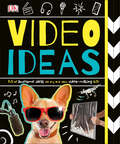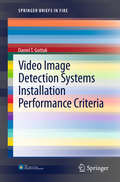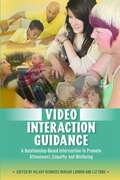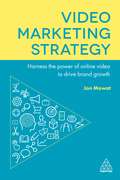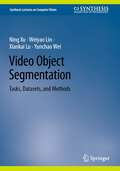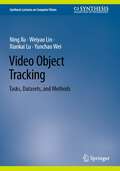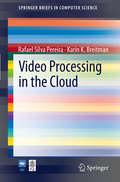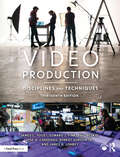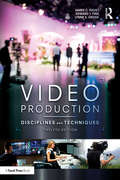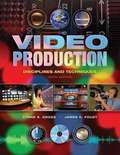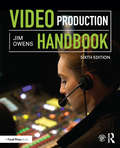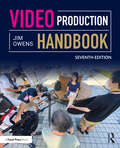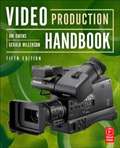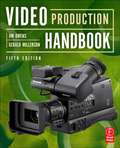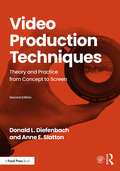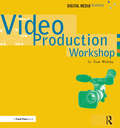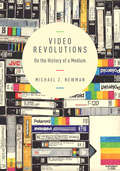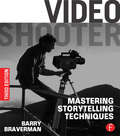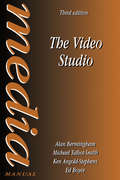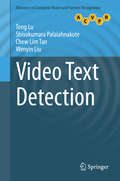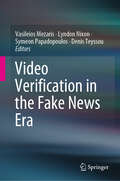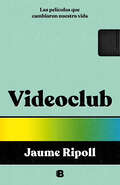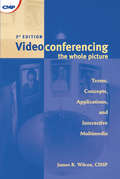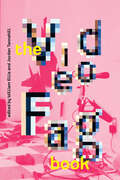- Table View
- List View
Video Ideas
by DKImagine and create awesome videos and animations to share with friends and family, and on YouTube, using phones, webcams, cameras, or camcorders.Inspirational and fun, this engaging book explores the video-making process from script to screen, with techniques to try out and practical tips to produce exciting projects at home. Discover how to get the best angles, lighting, and sound quality, and add special effects when recording using phone, webcam, camera, or camcorder. Turn footage into a finished product by adding visual effects with editing software, and find out how to format, upload, and create a trailer for the masterpiece. Whether you want to record special occasions, zany pets, action-packed sports events, a music video, or a stop-motion animation, Video Ideas has everything you need!The book's content supports the STEAM (Science, Technology, Engineering, Art, Math) approach to cross-curricular learning.
Video Image Detection Systems Installation Performance Criteria
by Daniel T. GottukVideo Image Detection Systems Installation Performance Criteria outlines fire performance objectives and related criteria for VID systems. The book also indentifies conceptual characteristic fire, smoke and nuisance scenarios within a series of selected environments, and examines related performance and installation issues as well. Video Image Detection Systems Installation Performance Criteria is designed for practitioners as a reference guide for implementing video systems capable of quickly detecting smoke and fire. Researchers working in a related field will also find the book valuable.
Video Marketing Strategy: Harness the Power of Online Video to Drive Brand Growth
by Jon MowatVideo is the single most effective tool that marketers have to raise brand awareness, increase sales, drive website traffic and deliver ROI on marketing budgets. Driven by consumer demand and with the backing of the largest social media platforms, our world is becoming 'video first'. Video Marketing Strategy allows marketers to harness the power of video and create effective video campaigns. This in-depth look at the world's most powerful medium helps brands to radically magnify their voice by tapping into a level of emotional engagement that can't be achieved any other way. The book explores both theory (why are humans so affected by video on mobile devices?) and practice (what's the key to making videos that deliver results?). It looks at how multiple videos form wider campaigns and covers content hubs, activation strategies and testing. It is filled with invaluable advice, tips and strategies for incorporating video into a wider content marketing plan. Written by an award-winning video marketer with decades of experience, Video Marketing Strategy gives readers the magic formula to create engaging, effective content. Truly global in scope, it features case studies from around the world, and shows how marketers from all sectors and industries have used video campaigns successfully. Featuring insights from prominent industry practitioners Video Marketing Strategy is jam-packed with guidance on how to make videos that cut through the market place and deliver measurable results.
Video Object Segmentation: Tasks, Datasets, and Methods (Synthesis Lectures on Computer Vision)
by Ning Xu Weiyao Lin Xiankai Lu Yunchao WeiThis book provides a thorough overview of recent progress in video object segmentation, providing researchers and industrial practitioners with thorough information on the most important problems and developed technologies in the area. Video segmentation is a fundamental topic for video understanding in computer vision. Segmenting unique objects in a given video is useful for a variety of applications, including video conference, video editing, surveillance, and autonomous driving. Given the revolution of deep learning in computer vision problems, numerous new tasks, datasets, and methods have been recently proposed in the domain of segmentation. The book includes these recent results and findings in large-scale video object segmentation as well as benchmarks in large-scale human-centric video analysis in complex events. The authors provide readers with a comprehensive understanding of the challenges involved in video object segmentation, as well as the most effective methods for resolving them.
Video Object Tracking: Tasks, Datasets, and Methods (Synthesis Lectures on Computer Vision)
by Ning Xu Weiyao Lin Xiankai Lu Yunchao WeiThis book provides a thorough overview of recent progress in video object tracking, allowing researchers and industrial practitioners to gain a better understanding of the most important problems and developed technologies in the area. Video tracking is a key research area in computer vision and aims to track unique objects in a given video, which are useful for various applications such as video conference, video editing, surveillance, and autonomous driving. This book begins with an introduction to the task of video object tracking, including the most common problem settings. Given the revolution of deep learning in computer vision problems, numerous new tasks, datasets, and methods have been recently proposed in the domain of video tracking. The book includes these recent results as well as benchmarks in large-scale human-centric video analysis in complex events.
Video Processing in the Cloud
by Rafael Silva Pereira Karin K. BreitmanAs computer systems evolve, the volume of data to be processed increases significantly, either as a consequence of the expanding amount of available information, or due to the possibility of performing highly complex operations that were not feasible in the past. Nevertheless, tasks that depend on the manipulation of large amounts of information are still performed at large computational cost, i.e., either the processing time will be large, or they will require intensive use of computer resources. In this scenario, the efficient use of available computational resources is paramount, and creates a demand for systems that can optimize the use of resources in relation to the amount of data to be processed. This problem becomes increasingly critical when the volume of information to be processed is variable, i.e., there is a seasonal variation of demand. Such demand variations are caused by a variety of factors, such as an unanticipated burst of client requests, a time-critical simulation, or high volumes of simultaneous video uploads, e.g. as a consequence of a public contest. In these cases, there are moments when the demand is very low (resources are almost idle) while, conversely, at other moments, the processing demand exceeds the resources capacity. Moreover, from an economical perspective, seasonal demands do not justify a massive investment in infrastructure, just to provide enough computing power for peak situations. In this light, the ability to build adaptive systems, capable of using on demand resources provided by Cloud Computing infrastructures is very attractive.
Video Production: Disciplines and Techniques
by James C. Foust Edward J. Fink Phil Beskid Jose A. Cardenas Robert Gordon Jr. James B. LohreyThis seminal text, now in its thirteenth edition, provides a comprehensive and accessible overview of the operations underlying video production.It provides thorough coverage of the theory and techniques readers need to know, balancing complexity with practical how-to information about detailed subjects in a concise, conversational style. The book has been updated to incorporate recent changes in the video production pipeline–emphasizing digital video, non-linear video production, streaming platforms, mobile production, and do-it-yourself video–while maintaining the foundational, nuanced, teamwork-based approach that has made the book popular.Chapters include key takeaways, review questions, on-set exercises, and QR codes, and a comprehensive glossary defines all the key production terms discussed. An accompanying eResource includes downloadable versions of the forms and paperwork used in the book, in addition to links to further online resources.
Video Production: Disciplines and Techniques
by Jim Foust Edward J Fink Lynne GrossThe revised twelfth edition of Video Production: Disciplines and Techniques introduces readers to the operations underlying video production. It provides thorough coverage of the theory and techniques readers need to know, balancing complexity with practical how-to information about detailed subjects in a concise, conversational style. The book has been updated to incorporate recent changes in the video production pipeline—emphasizing digital video, non-linear video production, streaming platforms, and mobile production—while maintaining the foundational, nuanced, teamwork-based approach that has made the book popular. Each chapter includes key takeaways, review questions, and on-set exercises, and a comprehensive glossary defines all the key production terms discussed. An accompanying eResource includes downloadable versions of the forms and paperwork used in the book, in addition to links to further online resources.
Video Production: Disciplines and Techniques (10th edition)
by Lynne S. Gross James C. FoustWritten in a readable style, this text introduces students to the operations underlying multiple-camera video production. In addition to covering technological skills and equipment, the text also emphasizes the importance of interpersonal skills, teamwork, and professionalism. Early chapters of the text overview the differences between studio, field, and remote truck production, review the duties of cast and crew, and outline crucial producing and directing functions. These chapters are followed by seven equipment chapters, and a final chapter on field production. B&w photos, drawings, chapter exercises, and a glossary are included. This tenth edition is revised and reorganized to take into account recent changes in the field of video production, with increased emphasis on digital and high-definition formats. It features annotated screen shot examples of nonlinear editing programs, information on preparing video for use on the Internet and portable devices, and additional emphasis throughout on video production for newscasts. There is also updated coverage of various file formats for traditional and alternate content delivery systems. A companion web site contains interactive exercises, review quizzes, flash cards for vocabulary review, downloadable sample forms, and video and audio clips demonstrating principles and techniques. Gross is affiliated with California State University-Fullerton. Foust is head of the Broadcast Journalism sequence in the Department of Journalism at Bowling Green State University. Annotation ©2008 Book News, Inc., Portland, OR (booknews. com)
Video Production Handbook
by Jim OwensTechniques matter! Great ideas don't automatically translate into great programs. It's not enough simply to show what is going on. The way you present your subject will influence how your audience responds. You need to choose your picture and sound carefully, to convey your ideas in an interesting, persuasive way. This book will show you how. Video Production Handbook shows the full production process, from inception of idea to final distribution. The book focuses especially on why each step occurs as it does and provides guidance in choosing the simplest methods of creating the shots you want in your video project. Concentrating on the techniques and concepts behind the latest equipment, this book demonstrates the fundamental principles needed to create good video content on any kind of budget. Suitable for students and beginning videographers, the new edition of this classic text retains its clarity and directness but has been completely revised and updated. This practical sourcebook has been specially prepared to give you an at-a-glance guide to quality video program-making on a modest budget. Emphasis throughout is on excellence with economy; whether you are working alone or with a small multi-camera group. The well-tried techniques detailed here will steer you through the hazards of production, helping you to avoid those frustrating, time-wasting problems, and to create an effective video program. For many years Video Production Handbook has helped students and program-makers in a wide range of organizations. Now in its thoroughly revised 4th edition, Video Production Handbook guides you step-by-step, explaining how to develop your initial program ideas and build them into a successful working format. It covers the techniques of persuasive camerawork, successful lighting and sound treatment, and video editing. You will find straightforward up-to-the-minute guidance with your daily production problems, and a wealth of practical tips based on the authors' personal experiences. * Highly visual: hundreds of full-color illustrations demonstrate techniques * Modern: Up-to-date information on current equipment, techniques, and new distribution outlets such as the Web and mobile phones * Balanced: Production techniques are covered in detail, but ideas and creative problem solving are given equal weight * A complete resource: Detailed teaching ancillaries are available for instructors
Video Production Handbook
by Jim OwensThis brand new edition walks students through the full video production process, from inception of idea to final distribution. Concentrating on the techniques and concepts behind the latest equipment, the book demonstrates the fundamental principles needed to create good video content on any kind of budget. Interviews with industry professionals provide insights into how the field really works and over 300 full color images of onsite work demonstrate how to achieve the techniques discussed. Ideal for students, the new edition features fully updated information on the latest DSLR and cinema cameras, LED lighting, digital distribution and much more.
Video Production Handbook 5th Edition
by Gerald Millerson Jim OwensTechniques matter! Great ideas don't automatically translate into great programs. It's not enough simply to show what is going on. The way you present your subject will influence how your audience responds. You need to choose your picture and sound carefully, to convey your ideas in an interesting, persuasive way. This book will show you how. Video Production Handbook shows the full production process, from inception of idea to final distribution. The book focuses especially on why each step occurs as it does and provides guidance in choosing the simplest methods of creating the shots you want in your video project. Concentrating on the techniques and concepts behind the latest equipment, this book demonstrates the fundamental principles needed to create good video content on any kind of budget. Suitable for students and beginning videographers, the new edition of this classic text retains its clarity and directness but has been completely revised and updated. This practical sourcebook has been specially prepared to give you an at-a-glance guide to quality video program-making on a modest budget. Emphasis throughout is on excellence with economy; whether you are working alone or with a small multi-camera group. The well-tried techniques detailed here will steer you through the hazards of production, helping you to avoid those frustrating, time-wasting problems, and to create an effective video program. * Highly visual: more than 450 full color photos and illustrations demonstrate techniques* Modern: Revised by Jim Owens, who brings a wealth of hands-on experience to the text; up-to-date information on current equipment, techniques, and new distribution outlets such as the Web and mobile phones* A complete resource: Detailed teaching ancillaries are available for instructors, including instructor's manual, test bank, sample syllabi, image collection, video content, and more * Brand new coverage of contemporary distribution methods* Interviews featuring industry professionals provide students with inside knowledge of the industry* Sidebars featuring new coverage of topics such as shooting for 3D, shooting with HDSLRs for video, and much more!
Video Production Handbook (5th Edition)
by Jim Owens Gerald MillersonTechniques matter! Great ideas don't automatically translate into great programs. It's not enough simply to show what is going on. The way you present your subject will influence how your audience responds. You need to choose your picture and sound carefully, to convey your ideas in an interesting, persuasive way. This book will show you how. Video Production Handbook shows the full production process, from inception of idea to final distribution. The book focuses especially on why each step occurs as it does and provides guidance in choosing the simplest methods of creating the shots you want in your video project. Concentrating on the techniques and concepts behind the latest equipment, this book demonstrates the fundamental principles needed to create good video content on any kind of budget. Suitable for students and beginning videographers, the new edition of this classic text retains its clarity and directness but has been completely revised and updated. This practical sourcebook has been specially prepared to give you an at-a-glance guide to quality video program-making on a modest budget. Emphasis throughout is on excellence with economy; whether you are working alone or with a small multi-camera group. The well-tried techniques detailed here will steer you through the hazards of production, helping you to avoid those frustrating, time-wasting problems, and to create an effective video program. * Highly visual: more than 450 full color photos and illustrations demonstrate techniques * Modern: Revised by Jim Owens, who brings a wealth of hands-on experience to the text; up-to-date information on current equipment, techniques, and new distribution outlets such as the Web and mobile phones * A complete resource: Detailed teaching ancillaries are available for instructors, including instructor's manual, test bank, sample syllabi, image collection, video content, and more * Brand new coverage of contemporary distribution methods * Interviews featuring industry professionals provide students with inside knowledge of the industry * Sidebars featuring new coverage of topics such as shooting for 3D, shooting with HDSLRs for video, and much more!
Video Production Techniques: Theory and Practice From Concept to Screen (Lea’s Communication Series)
by Donald L. DiefenbachVideo Production Techniques begins with the basic skills of video production, so students experience writing, shooting and editing right away. It then moves to short-form projects and in-depth explorations of lighting and sound, concluding with an exploration of documentaries, news, and other nonfiction forms. The final section is dedicated to advanced applications, including the process of creating long-form projects, the elements of directing, and strategies for effective marketing and distribution. The book concludes with a chapter exploring professional opportunities in production and options for further study.
Video Production Techniques: Theory and Practice from Concept to Screen
by Donald L Diefenbach Anne E SlattonVideo Production Techniques is an essential guide to the art and craft of video production. It introduces students to the theoretical foundations as well as the practical skills needed to make a successful video project. The opening chapter introduces the reader to the language of motion pictures and sets the stage for effective visual storytelling. Unit I guides students through the theory, techniques, and processes of writing, shooting, and editing video productions. Unit II expands on these basic principles to explore the crafts of sound recording/design, lighting, and directing. Unit III surveys the industries, formats, and methods for creating fiction and nonfiction programs. The final unit of the text examines options for distribution and career opportunities in video production. Newly updated and revised, the second edition of Video Production Techniques unifies theory and practice for instructors and students. It is a great tool for use in introductory-level video production courses and for the independent learner. The accompanying companion website features instructor resources including a sample syllabus, quiz bank, sample assignments, and PowerPoint slides for each chapter, alongside illustrative video demonstrations for students.
Video Production Workshop: DMA Series (Dv Expert Ser.)
by Tom WolskyVideo Production Workshop is the first book written to be accessible and appealing to a younger, digitally savvy audience interested in learning the full range of skills involved in planning and executing a video project. It introduces all the digital tools and basic techniques in sequence for readers to build proficiency and gain a well-rounded mastery of the art and craft of video production. Author Tom Wolsky begins with lessons in video editing and camera handling, and then moves on to scripting and storyboarding a production. Readers then step through a series of exercise projects. Separate chapters explore how to light different types of scenes as well as how to obtain well-recorded sound. The book is designed both for independent students as well as for classroom use, and it includes lessons on video journalism and its rights, responsibilities, and ethics. Related techniques for interviewing and working in a live studio are also presented. The book concludes with lessons in post-production techniques, especially motion graphics and special effects. The downloadable resources are packed with DV footage for projects, plus demo plug-ins and free software.
Video Revolutions: On the History of a Medium
by Michael Z. NewmanSince the days of early television, video has been an indispensable part of culture, society, and moving-image media industries. Over the decades, it has been an avant-garde artistic medium, a high-tech consumer gadget, a format for watching movies at home, a force for democracy, and the ultimate, ubiquitous means of documenting reality. In the twenty-first century, video is the name we give all kinds of moving images. We know it as an adaptable medium that bridges analog and digital, amateur and professional, broadcasting and recording, television and cinema, art and commercial culture, and old media and new digital networks. In this history, Michael Z. Newman casts video as a medium of shifting value and legitimacy in relation to other media and technologies, particularly film and television. Video has been imagined as more or less authentic or artistic than movies or television, as more or less democratic and participatory, as more or less capable of capturing the real. Techno-utopian rhetoric has repeatedly represented video as a revolutionary medium, promising to solve the problems of the past and the present—often the very problems associated with television and the society shaped by it—and to deliver a better future. Video has also been seen more negatively, particularly as a threat to movies and their culture. This study considers video as an object of these hopes and fears and builds an approach to thinking about the concept of the medium in terms of cultural status.
Video Shooter: Mastering Storytelling Techniques (Dv Expert Ser.)
by Barry BravermanTired of the all the digital filmmaking guidebooks that give you only the nuts and bolts of how to use a camera? The third edition of Video Shooter takes the how-to knowledge a step further by showing you how to craft a story in your video. Barry Braverman is an experienced shooter and filmmaker whose is highly regarded in the field. This book covers everything from framing a shot, to lighting, to the type of camera (and tripod) you should use, and perhaps most importantly--how to translate the use of all this equipment and techniques into a story. The author is a veteran cinematic storyteller, and he shares practiced film-style techniques for use on your own DV cam.Humorous and opinionated, the author provides anecdotes and full-color illustrations that help you to learn the tricks of the trade. He gets right to the point of what you need to know to get good shots-and on a budget. New to this edition: * more up-to-date techniques involving HD technology* more coverage on the multi-skillset required of today's filmmakers (who are asked to act simultaneously as Director, Director of Photography, Cinematographer, Sound Recordists, etc.)*Website including craft tips, equipment review/blogs, and a teacher's corner to support use of the book in film studies/digital media class (includes student work completed in class using the text)
The Video Studio
by Alan Bermingham Michael Talbot-Smith Ed Boyce Ken Angold-StephensThe recent demise of the independent television companies and the expansion of satellite and cable networks has led to an explosion in small, independent production facilities. In parallel with this development has been a steady increase in media training and a major expansion in corporate video facilities. The Video Studio is written for everyone contemplating setting-up a professional installation, whether studio or location based. The Video Studio shows how to estimate the scale of investment required and, depending on the nature and frequency of use of the facility, the layout of technical areas and the function of the main items of equipment is described in easy to understand language. In short this is a nuts and bolts approach to planning and operating a studio of 150 square metres or less. Completely updated to take account of all the recent technological advances which have taken place, the book now covers: DAT, timecode, digital compression, non-linear editing and all current digital video formats.
Video Text Detection
by Tong Lu Shivakumara Palaiahnakote Chew Lim Tan Wenyin LiuThis book presents a systematic introduction to the latest developments in video text detection. Opening with a discussion of the underlying theory and a brief history of video text detection, the text proceeds to cover pre-processing and post-processing techniques, character segmentation and recognition, identification of non-English scripts, techniques for multi-modal analysis and performance evaluation. The detection of text from both natural video scenes and artificially inserted captions is examined. Various applications of the technology are also reviewed, from license plate recognition and road navigation assistance, to sports analysis and video advertising systems. Features: explains the fundamental theory in a succinct manner, supplemented with references for further reading; highlights practical techniques to help the reader understand and develop their own video text detection systems and applications; serves as an easy-to-navigate reference, presenting the material in self-contained chapters.
Video Verification in the Fake News Era
by Vasileios Mezaris Lyndon Nixon Symeon Papadopoulos Denis TeyssouThis book presents the latest technological advances and practical tools for discovering, verifying and visualizing social media video content, and managing related rights. The digital media revolution is bringing breaking news to online video platforms, and news organizations often rely on user-generated recordings of new and developing events shared in social media to illustrate the story. However, in video, there is also deception. In today's "fake news" era, access to increasingly sophisticated editing and content management tools and the ease with which fake information spreads in electronic networks, require the entire news and media industries to carefully verify third-party content before publishing it. As such, this book is of interest to computer scientists and researchers, news and media professionals, as well as policymakers and data-savvy media consumers.
Videoclub: Las películas que cambiaron nuestra vida
by Jaume RipollUNA HISTORIA DE PELÍCULA DE LA MANO DEL COFUNDADOR DE FILMIN Esta es la historia de un niño con sobrepeso y acné que se despertaba de madrugada para ver películas. Esta también es la historia del padre de ese niño, propietario de videoclubs, coleccionista de VHS y el hombre que pensaba que la mejor educación para su hijo era el cine. Esta es la historia de cómo el cine puede cambiar nuestras vidas y hacerlas mejores.Jaume Ripoll, cofundador de Filmin -una de las plataformas de cine más prestigiosas de los últimos tiempos- nos relata en este libro su historia de amor incondicional con el séptimo arte. De su mano, volveremos a los videoclubs de barrio en un recorrido nostálgico y fascinante lleno de anécdotas y recomendaciones que nos harán (re)descubrir y recuperar las obras imprescindibles que marcaron varias generaciones. «He hecho un viaje de espectador a distribuidor, del placer al trabajo, y ahora escribo este libro con la esperanza de que restaure parte de la ilusión perdida y permita al lector descubrir y recuperar obras que posiblemente han significado tanto en su vida como lo han hecho en la mía. Al fin y al cabo, el cine es una experiencia solitaria que se disfruta en compañía». La crítica ha dicho:«Jaume Ripoll nos ofrece una panorámica certera de los últimos 30 años de cine en este país; del siglo XX al XXI, entre rebobinados, recs y pausas. Un libro que es autobiografía, novela de aprendizaje y manual de supervivencia. Lleno de gracia e inteligencia, respira amor por el cine en cada página».Jonás Trueba «Una emocionante celebración del cine».El Periódico«Un libro rebosante de nostalgia, anécdotas, confesiones, reflexiones sobre el devenir de una industria cinematográfica… un canto de amor al cine».David Gallardo, Infolibre «Un conmovedor homenaje al cine».Vogue «Unas deliciosas memorias».Oskar Belategui, El Correo«Muy interesante».El País «Una delicia que se acaba demasiado pronto».Saltos de Eje
Videoconferencing: The Whole Picture
by James R. WilcoxThis text aims to help the reader understand all aspects of videoconferencing. It includes: an overview of the history and technology; a section on security for Internet-based videoconferencing as well as expanded coverage of standards.
The Videofag Book
by Jordan Tannahill William EllisLonglisted for the 2018 Toronto Book AwardsIn October 2012, lovers William Ellis and Jordan Tannahill moved into a former barbershop in Toronto's Kensington Market neighbourhood and turned it into an art space called Videofag. Over the next four years Videofag became a hub for counterculture in the city, playing host to a litany of performances, screenings, parties, exhibitions, and all manner of queer fuckery. But hosting a city in their house took its toll and eventually William and Jordan broke up, closing the space for good in June 2016.The Videofag Book is a chronicle of those four years told through multiple voices and mediums: a personal history by William and Jordan; a love letter by Jon Davies; a communal oral history compiled by Chandler Levack; a play by Greg MacArthur; a poem by Aisha Sasha John; a chronological history of Videofag's programming; and a photo archive curated by William and Jordan in full colour.
